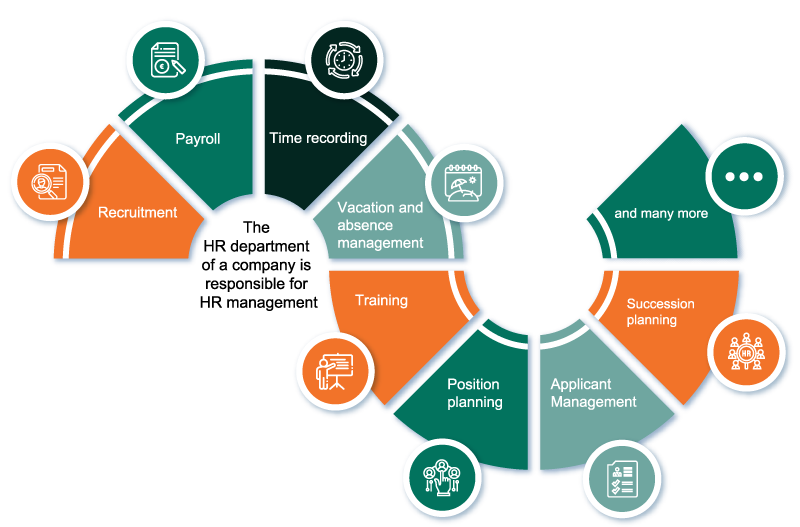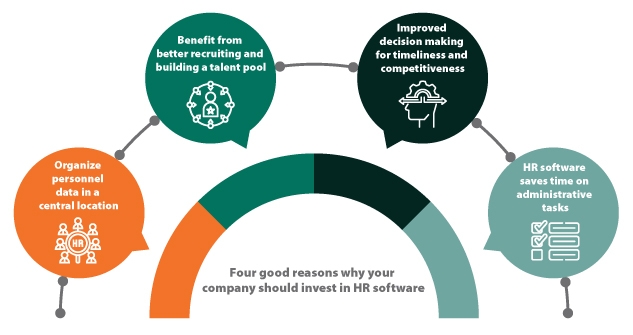Human Resources (HR) is the term for the totality of people in a business unit or the totality of the workforce of a company or organization. The HR department of a company is responsible for HR management. It takes care of the following areas and tasks, among others:

The term HR software is used to refer to individual areas such as time management or applicant management as well as the entire field.
The HR department is responsible for all tasks and processes related to the relationship between employer and employee. The larger the company or the more employees the company has, the more extensive and labor-intensive are the tasks of the HR department. Payroll, shift planning, schedules, recording activities, and many other tasks fall to the HR department. This variety of tasks and requirements is also reflected in the HR software.
A survey by statista.com in 2012 found out that over 86% of all companies surveyed with over 250 employees used software for payroll. Over 83% of companies with a size of 250 employees or more used software for time management and more than half used programs for workforce scheduling. About half of the companies with more than 2000 employees used software for personnel administration and applicant management. In companies with fewer employees, software was used significantly less often for time management, workforce scheduling or applicant management. But even small companies with only a few employees can benefit immensely from HR software solutions or the use of specific modules for selected HR areas.
Over time, the requirements for human resources management have changed. This concerns, for example, legal requirements for the recording of working hours or also the data protection. The software for this area of human resources has been adapted to these changes and is continuously being expanded.
Four good reasons why your company should invest in HR software

The more employees a company has, the more extensive the administrative tasks usually become. With two or three employees, vacation planning or time accounting can still be done with a small spreadsheet. With twenty or two hundred employees, this is confusing and hardly feasible. Errors creep in because perhaps a handwritten note or an e-mail with important information was overlooked.
HR software can support the diverse work that occurs in a personnel administration. The organization can usually be improved and errors reduced by software, so that HR processes become more efficient and at the same time more precise.
1) Organize personnel data in a central location
A particularly important reason for using HR software is the central organization and storage of HR master data. When this is done in a single place, this sensitive and personal data can be better protected from unauthorized access. It is easier to keep it up to date. The error rate during entering data is reduced, as the data only needs to be added or changed in a single place.
The data security of employees' personal data is an important aspect. Only designated employees in the HR department or the respective supervisors should have access to the sensitive data. In addition, access from the outside through a cyber attack etc. should also be prevented as far as possible. In addition to possible data leaks, however, certain other requirements of the GDPR such as deletion periods, obligation to provide information, right to rectification, etc. must also be taken into account. Here, too, the use of appropriate software is advantageous, in which basic settings can be made for such deadlines and generally for data access via user and rights management.
HR software can also ensure that all information about an employee is available in a single digital personnel file. No more time-consuming searches for scattered information about the employment contract, instructions given, training courses, certificates, pay slips or other data.
2) Benefit from better recruiting and building a talent pool
Finding the right employees is often difficult, because qualified staff is becoming increasingly scarce. Applicants nowadays can choose from many possible vacancies. For employers, it is therefore particularly important to design an application process that is as simple as possible and at the same time streamlined and appealing. HR software can provide precisely the crucial platform and the necessary functions for a perfect candidate experience.
Whether it is job planning, the publication of jobs on various portals, internal application processes, application forms or resume review, HR software can structure, optimize and automate many processes. Data can be exchanged faster and easier and, above all, independent of location, a pool of internal and external applicants can be managed, and the transfer of data from applicant management to the digital personnel file is also straightforward. Furthermore, HR software not only helps to build up a talent pool, but also to promote these talents in the long term and to bind them to the company.
3) Improved decision making for timeliness and competitiveness
HR software can support management and HR managers by providing the data and information needed for decisions more quickly. For strategically important personnel decisions, not only current data is required, but also often interlinked information, for example, about specific tasks and the time required for them, etc. It is also necessary to respond to changing boundary conditions in the labor market. For example, do employees prefer flexible working time arrangements? Should preventive health measures be offered? Does a company bicycle or a ticket for local public transportation tilt the scales in favor of a candidate's acceptance? All of this can be mapped with the help of an appropriate HR suite.
But the software also makes it easier to evaluate data on employee skills. This then offers better decision-making scope for the planning of further training and for personnel development as a whole.
4) HR software saves time on administrative tasks
The personnel management programs are usually able to automate a large part of the routine administrative tasks. These include, for example, the entry and processing of vacation requests, the preparation of payrolls, and changes to bank details or addresses. HR suites can provide numerous self-services that reduce the workload for HR staff. The manual effort required for individual administrative tasks can usually be significantly reduced through the use of software. The same also applies, for example, to tasks related to feedback processes. A continuous feedback system with automated workflows can ensure faster remediation of problems and greater employee satisfaction.
In addition, processing time is generally reduced when paper files no longer have to be moved from office A to office B, but user and rights management ensures access to digital files. Further time can be saved by linking the individual HR processes via the software.
Conclusion
Digitizing HR management brings benefits to all companies, regardless of size. HR software supports the creation of a central data structure for personnel data and, by automating routine administrative activities, gives HR managers and HR staff more time for important strategic considerations. HR programs improve the decision-making basis for these strategic planning activities. A good HR management program is the basis for productive work in the company and for the successful, competitive further development of personnel.